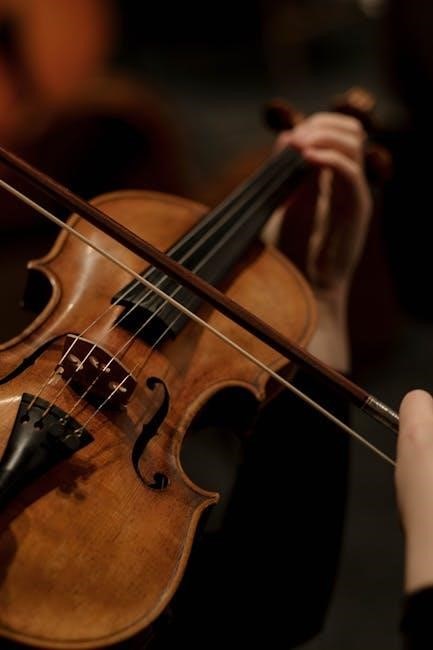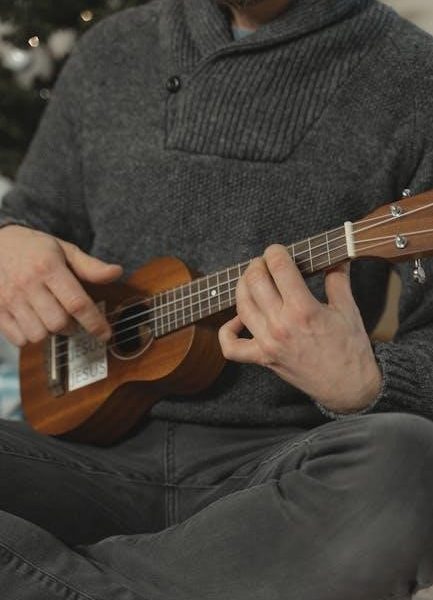The Minuet in G Major, often attributed to Johann Sebastian Bach, is a beloved piano piece from the Notebook for Anna Magdalena Bach. Composed by Christian Petzold, it is a 32-measure work in G major, known for its elegance and simplicity. This piece is a staple in piano education, offering a delightful introduction to Baroque music for students and enthusiasts alike.
Background of the Minuet in G Major
The Minuet in G Major, often mistakenly attributed to Johann Sebastian Bach, is actually composed by Christian Petzold. It first appeared in the 1725 Notebook for Anna Magdalena Bach, a collection of pieces for domestic use. This 32-measure work in G major is known for its simplicity and elegance, making it a popular choice for piano students. Its gentle tempo and straightforward structure allow learners to focus on timing and articulation. The piece has become a staple in Baroque music education, offering a charming introduction to the era’s stylistic characteristics while remaining accessible to intermediate players.
Historical Context and Composer Attribution
The Minuet in G Major is often mistakenly attributed to Johann Sebastian Bach but is actually the work of Christian Petzold, a German composer. It first appeared in the 1725 Notebook for Anna Magdalena Bach, a collection of pieces intended for domestic use. Despite its misattribution, the piece has gained significant popularity due to its elegant simplicity. Petzold’s composition reflects the musical tastes of the early 18th century, blending Baroque charm with approachable harmonies. Its historical significance lies in its enduring appeal, making it a beloved piece for both performance and study, particularly in piano education.
Popularity and Recognition of the Piece
The Minuet in G Major has gained widespread recognition for its melodic charm and accessibility. Often featured in piano tutorials and educational materials, it is a favorite among students and classical music enthusiasts. Its catchy melody and elegant structure make it a staple in Baroque music repertoire. Despite its misattribution to Bach, the piece remains highly celebrated, with numerous arrangements available for various instruments. Its popularity extends to modern platforms, where it is frequently downloaded as sheet music and performed in both traditional and contemporary settings, ensuring its enduring appeal across generations of musicians and audiences alike.

The Composition Itself
The Minuet in G Major is a 32-measure instrumental piece in G major, showcasing a simple yet elegant structure. Its melodic charm and harmonic balance reflect Baroque composition principles, making it a timeless piece for study and performance.
Structure and Musical Form
The Minuet in G Major is structured as a binary form, consisting of two contrasting sections. The piece spans 32 measures, with a clear separation between the first and second parts. The first section introduces the main theme, while the second section develops it further, often modulating to a related key. The composition follows a balanced phrasing structure, typical of the Baroque era, with each section ending on a strong cadence. This form allows for a harmonious flow, making it both pleasing to the ear and structured for performance. The 3/4 time signature underscores its dance-like character, emphasizing rhythmic clarity and grace.
Key Signature and Tonality
The Minuet in G Major is written in the key of G major, characterized by its bright and joyful tonality. The key signature features one sharp (F#), which contributes to the piece’s lively and uplifting character. The tonality remains consistent throughout, with occasional modulations that enhance harmonic interest. The music’s stability in G major creates a sense of balance, while the Baroque-era composition techniques add depth to its tonal structure. This key choice aligns with the dance-like nature of the minuet, making it both accessible and delightful for performers and listeners alike.
Tempo and Time Signature

The Minuet in G Major is written in a 3/4 time signature, typical of the minuet dance form, with a moderate tempo marked as Allegretto. This tempo supports the piece’s graceful and rhythmic nature, allowing for precise articulation and a lively yet controlled performance. The consistent meter and tempo guide pianists in maintaining the dance-like character, while slight variations in phrasing can enhance expressive qualities. The time signature and tempo work together to create a sense of balance and flow, making the piece both accessible and enjoyable for performers and listeners familiar with Baroque musical styles.
Genre and Stylistic Characteristics
The Minuet in G Major belongs to the Baroque genre, characterized by its elegant and refined style. Composed by Christian Petzold, it features balanced phrasing, simple harmonies, and a dance-like rhythm typical of the minuet form. The piece showcases a classic Baroque structure with a song-like melody, making it both accessible and enjoyable for performers. Its stylistic traits include light ornaments and a moderate tempo, reflecting the era’s musical aesthetics. This composition is a prime example of Baroque music’s clarity and grace, offering a delightful blend of simplicity and sophistication for pianists and music enthusiasts alike.

Sheet Music and PDF Availability
The Minuet in G Major is widely available as a downloadable PDF, often for free, from platforms like Piano Street and other sheet music repositories. Many versions include fingerings and arrangements suitable for educational purposes, making it easily accessible for pianists of various skill levels.
Downloading the Minuet in G Major PDF
Downloading the Minuet in G Major PDF is straightforward, with numerous platforms offering free and high-quality versions. Websites like Piano Street and sheet music repositories provide instant access to the piece, often with fingerings and transposition options. Many arrangements cater to pianists of all levels, ensuring accessibility for both beginners and advanced players. Additionally, some versions include MIDI files and practice videos, enhancing the learning experience. The PDF format ensures compatibility across devices, making it easy to print or view digitally. This convenience has made the Minuet in G Major a popular choice for pianists worldwide.
BWV Number and Cataloging
The Minuet in G Major is cataloged as BWV Anh. 114, indicating its inclusion in the appendix of Johann Sebastian Bach’s works. This classification reflects that the piece was not definitively composed by Bach but is often associated with his collections. Christian Petzold, a contemporary of Bach, is now recognized as the actual composer. Despite this, the piece remains popularly linked to Bach’s name, particularly through its inclusion in the Notebook for Anna Magdalena Bach, a collection of music compiled for his wife. This cataloging detail highlights the nuanced history behind the piece’s authorship and its enduring connection to Bach’s legacy.
BWV Anh. 114
– Composer: Christian Petzold
– Associated with: Johann Sebastian Bach
– Collection: Notebook for Anna Magdalena Bach
– Key: G Major
– Cataloging Note: BWV Anh. indicates an appendix entry, reflecting uncertain authorship.
Sheet Music Platforms and Sources
The Minuet in G Major is widely available across various sheet music platforms. Websites like Piano Street and Musicnotes offer high-quality PDF downloads, often with additional features such as MIDI files, practice videos, and transposition options. Platforms like Sheet Music Plus and IMSLP provide both free and premium versions, catering to different user needs. Some sites, such as PianoXML, specialize in piano arrangements, ensuring accuracy and authenticity. These platforms are ideal for pianists seeking reliable sources to download and print the sheet music, whether for educational purposes or personal enjoyment.
Quality and Arrangements of the PDF
The Minuet in G Major PDF is available in high-quality formats, ensuring clarity and precision for pianists. Many versions include fingerings, dynamics, and expressive markings, edited by experts like Oriol Lopez Calle. Some arrangements offer transposition options, allowing adaptation to different skill levels; Practice videos and MIDI files accompany certain downloads, aiding in learning and performance. The PDFs are meticulously arranged, preserving the Baroque style while catering to modern pianists. Whether for educational use or personal enjoyment, the sheet music is presented in a professional and accessible manner, making it a valuable resource for musicians of all levels.
Performance Techniques
Mastering the Minuet in G Major requires attention to dynamics, expressive markings, and articulation. Pianists should emphasize a light, graceful touch with precise timing and phrasing, enhancing its Baroque charm.
Playing Tips for Pianists
When performing the Minuet in G Major, pianists should maintain a steady tempo and emphasize a light, graceful touch. Dynamics should be subtle, with soft playing predominant, allowing for gentle crescendos. Articulation is key—opt for a legato style to create a smooth, flowing sound. Ornamentation should be minimal to preserve the piece’s elegance. Practice slowly to ensure precision, then gradually increase speed. Use a metronome to maintain consistency. Highlight the melody while balancing accompaniment voices. Focus on phrasing and expressive markings to bring out the Baroque character. Emotional expression will enhance the performance, making it both engaging and authentic.
Dynamics and Expressive Markings
The Minuet in G Major features delicate dynamics, primarily marked as pianissimo or mezzo-piano, with subtle crescendos to enhance musicality. Expressive markings guide pianists to play with a light, graceful touch, fostering an elegant Baroque character. Phrasing should be legato, with slight rubato for emotional depth. Dynamic contrasts are minimal, focusing on gentle shifts rather than dramatic changes. This approach preserves the piece’s refined and dance-like quality, allowing the melody to shine while maintaining balance and restraint.
Articulation and Touch
The Minuet in G Major requires precise articulation, with a mix of legato and staccato markings to achieve a lively yet refined sound. Pianists should employ a light, detached touch for the staccato passages, while maintaining a smooth, connected phrasing in legato sections. The right-hand melody often calls for a singing tone, supported by a subtle accompaniment in the left hand. Finger independence and control are essential to execute the intricate Baroque ornamentations, ensuring clarity and grace. Proper articulation enhances the dance-like character of the piece, making it both technically challenging and musically rewarding to perform.
Ornamentation and Embellishments
The Minuet in G Major features delicate ornamentation typical of Baroque music, including trills and mordents that enhance its elegance. These embellishments are particularly evident in the right-hand melody, adding a decorative touch while maintaining the piece’s grace. Pianists should execute ornaments with restraint, adhering to historical performance practices to preserve the music’s refined character. The original composition includes specific ornaments, though some arrangements may vary. To ensure authenticity, pianists should consult the sheet music or PDF sources, such as those from Bach’s Notebook for Anna Magdalena Bach, to accurately interpret these embellishments and uphold the piece’s musical integrity.

Cultural and Historical Significance
The Minuet in G Major holds a cherished place in Baroque music, reflecting the era’s musical tastes and dance traditions. Its inclusion in Anna Magdalena Bach’s Notebook highlights its cultural importance as a domestic piece, enjoyed by both professionals and amateurs. The minuet’s enduring popularity bridges past and present, making it a timeless classic celebrated across generations and performances.
Role in the Baroque Era

The Minuet in G Major exemplifies the Baroque era’s musical elegance, reflecting the period’s dance traditions. Composed by Christian Petzold, it was included in Anna Magdalena Bach’s Notebook, showcasing its domestic appeal. The piece captures the refined and structured qualities of Baroque music, with its balanced phrasing and harmonic clarity. As a popular dance form, the minuet was integral to courtly life, and this composition embodies the era’s musical sophistication. Its accessibility made it a favorite for both amateur and professional performers, highlighting its enduring cultural relevance and charm during the Baroque period.
Connection to Anna Magdalena Bach
The Minuet in G Major is famously found in the Notebook for Anna Magdalena Bach, a collection compiled by Johann Sebastian Bach for his wife. This notebook was a personal gift, containing compositions by Bach, his contemporaries, and other artists. Christian Petzold, a contemporary of Bach, is believed to have composed this piece. Its inclusion in the notebook highlights Anna Magdalena’s role as a skilled musician and her appreciation for elegant, domestic music. The minuet’s presence in this personal collection underscores its significance as a piece for intimate performance, reflecting the musical tastes of the Bach family and their circle.
Modern-Day Performances and Adaptations
The Minuet in G Major remains a popular choice for modern performances and adaptations, transcending its Baroque origins. Musicians often perform it on various instruments, from piano and violin to flute and guitar, showcasing its timeless appeal. Contemporary artists and ensembles frequently include it in their repertoire, blending traditional techniques with modern interpretations; Additionally, the piece has been adapted for digital platforms, with MIDI files and practice videos available online. Its presence in media and popular culture further highlights its enduring influence, making it a bridge between classical and contemporary music, accessible to diverse audiences and generations.

Learning and Educational Value
The Minuet in G Major is a valuable educational piece, ideal for developing finger dexterity and musical phrasing. Its simplicity and structure make it perfect for intermediate piano students, enhancing their understanding of Baroque music while building foundational skills essential for more complex repertoire.
Use in Piano Education
The Minuet in G Major is widely used in piano education due to its accessible structure and melodic charm. It is particularly suitable for intermediate students, as it reinforces finger dexterity, articulation, and phrasing. The piece is often assigned at the Grade 3 level, introducing students to the Baroque style while developing their technical and expressive skills. Its clear rhythmic patterns and harmonies make it an excellent tool for teaching time signature awareness and dynamic control. Additionally, its popularity ensures it is frequently performed in recitals and exams, providing students with a confidence-building repertoire piece.
Grade Level and Difficulty
The Minuet in G Major is typically assigned at a Grade 3 level, making it accessible to early intermediate pianists. Its moderate difficulty involves straightforward fingerings and a manageable tempo, allowing students to focus on musicality. While technically undemanding, it requires attention to articulation, dynamics, and phrasing to capture its Baroque character. The piece is an excellent stepping stone for developing coordination and control, particularly in maintaining a steady rhythm and executing ornaments with precision. Its popularity in educational settings stems from its balanced challenge and artistic appeal, making it a rewarding piece for students to master.
Skills Developed Through Playing
Playing the Minuet in G Major enhances finger dexterity, hand coordination, and rhythmic accuracy. It refines articulation, dynamics, and phrasing, essential for Baroque music. Students develop control over tempo and expression, fostering musicality. The piece also improves ornamentation techniques and nuanced touch, preparing pianists for more complex repertoire. By mastering this work, learners strengthen their ability to interpret historical styles while cultivating precise and expressive performance skills, making it a valuable addition to any pianist’s educational journey.

Modern Interpretations and Arrangements
The Minuet in G Major remains popular with modern orchestras and jazz bands, often featured in movies and commercials. Its timeless melody adapts well to various styles, from electronic remixes to classical fusions, making it a versatile piece for contemporary performances and media. PDF arrangements are widely available for these interpretations.
Instrumental Arrangements Beyond Piano
The Minuet in G Major has been adapted for various ensembles, showcasing its timeless appeal. Orchestral arrangements feature strings, woodwinds, and brass, while jazz bands often reinterpret it with vibrant rhythms. Chamber music groups, including violin and cello duets, highlight the piece’s harmonic richness. Even electronic and pop artists have reimagined it, blending classical melodies with modern beats. These diverse arrangements demonstrate the composition’s versatility, making it a favorite across genres. PDF scores for these interpretations are widely available, allowing musicians to explore the piece beyond its traditional piano setting.

Contemporary Performances and Recordings
The Minuet in G Major remains a popular choice for modern performers, with countless recordings available across digital platforms. Artists and ensembles frequently reinterpret the piece, blending traditional interpretations with innovative styles. Jazz bands, orchestras, and solo instrumentalists have all reimagined it, showcasing its timeless appeal. YouTube features numerous renditions, from classical pianists to experimental arrangements. Additionally, modern platforms like Apple Music and Spotify offer high-quality recordings, making the piece accessible to global audiences. These contemporary performances highlight the enduring charm of the Minuet in G Major, ensuring its relevance in today’s musical landscape.
Use in Media and Popular Culture
The Minuet in G Major has become a staple in media and popular culture, frequently featured in films, TV shows, and commercials to evoke a classical or nostalgic ambiance. Its timeless melody has been adapted for various contexts, from romantic scenes in movies to background music in advertisements. Additionally, the piece is often used in educational content, such as piano tutorials and music theory lessons, due to its simplicity and recognizability. Its widespread use in media has further cemented its place as one of the most beloved and accessible classical compositions, transcending traditional concert settings to reach a broad audience.

Resources and Downloads
Download the Minuet in G Major PDF from reputable sources like Piano Street or Musicnotes. High-quality sheet music, MIDI files, and practice videos are widely available online.
Recommended Websites for PDF Download
Piano Street, Musicnotes, and IMSLP are top choices for downloading the Minuet in G Major PDF. These platforms offer high-quality sheet music, with options for free or paid versions. Piano Street provides exclusive arrangements, while Musicnotes includes interactive features. IMSLP offers a vast library of classical pieces, including BWV Anh.114. Ensure you select versions with clear notation and fingerings for optimal learning. Some sites also offer MIDI files and practice videos to aid in mastering the piece.
Additional Learning Resources
Beyond sheet music, YouTube tutorials and piano learning apps offer detailed guides for mastering the Minuet in G Major. Piano Street provides comprehensive lessons, while video tutorials by experts like Piano Nanny break down techniques. Apps such as Piano Maestro include interactive exercises. For intermediate learners, practice videos and MIDI files help refine timing and dynamics. These resources complement PDF downloads, ensuring a well-rounded learning experience. They cater to both beginners and advanced players, making the piece accessible to all skill levels while maintaining its timeless charm and educational value.


